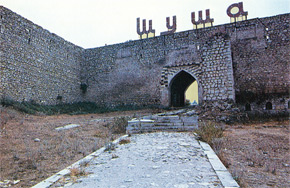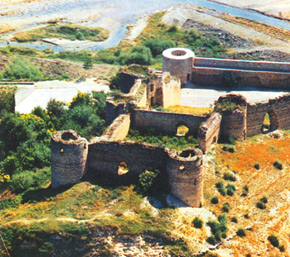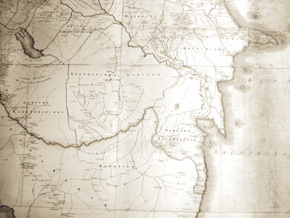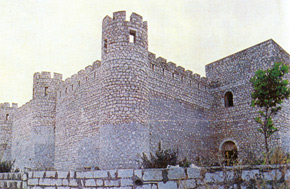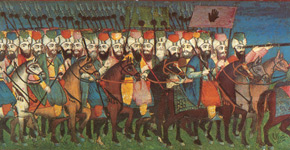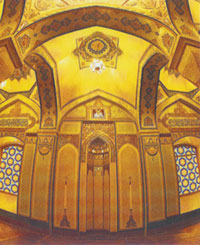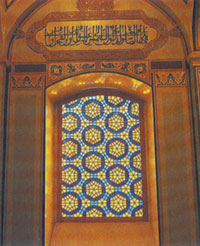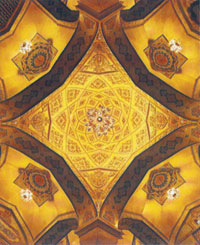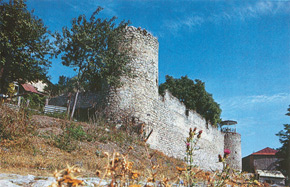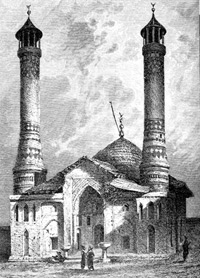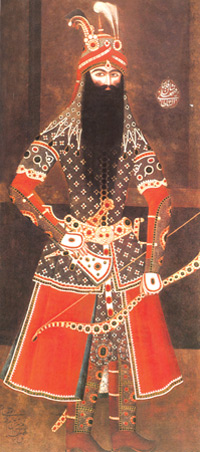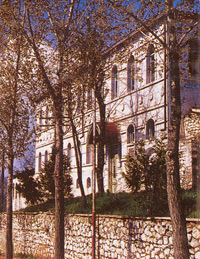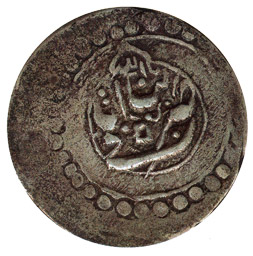 Pages 38-48
Pages 38-48by Prof. Fuad Aliyev
The Karabagh Khanate was formed against a background of constantly shifting political power. From 1724 the entire western part of Azerbaijan was occupied by the forces of Ottoman Turkey, which meant that the Karabagh Governorate (beylerbeyi) and city of Ganja were in Turkish hands. Local militia fighters under the command of their feudal lords fought alongside the regular army, commanded by the future leader of the Iranian state, Nadir Kuly Khan, and drove the Ottoman troops out of the South Caucasus in 1735.
Nadir Kuly Khan helped the local feudal lords, inviting the most talented to Iran and giving them senior positions. They included representatives of the Javanshir tribes - the brothers Fazlaly Bey and Panah Ali Bey. Panah Ali Bey was appointed military emir, and Fazlaly Bey was given the honourable role of eshik agasi (master of ceremonies).
Nadir Shah deports Karabagh tribes to Central Asia
After Nadir Kuly ascended the Iranian throne as Nadir Shah in 1736, he treated the Karabaghis harshly. This was because during the coronation in the Mugam kurultay (congress) almost all the Karabagh feudal lords, including representatives of the tribes of Ziyad oglu, Iyirmi dord (Twenty Four), Otuz iki (Thirty Two), Javanshir and others opposed Nadir Kuly Khan’s candidature. They "tried to ensure that only the Safavids became shah and that no-one else should take the throne". Therefore, after the coronation process was over, Nadir Shah took retribution on the population of Karabagh. He put the Ilats, Kazakhs and Borchalu, which had been subordinated to the Karabagh Governorate with their feudal lords (elbeys), under the tsar of Kartli-Teymuraz. The people of the tribes of Javanshir, Otuz iki and Kebirli were ordered to move to the Sarakha region of Khorasan Province (vilayet) and the border with Afghanistan. At the same time the Albanian lords (meliks) were given "independence", that is, they were no longer subordinate to the Ganja-Karabagh Governorate, but directly to the shah. [2, p. 47]Panah Ali Bey and Fazlali Bey were both greatly concerned by the resettlement of a large number of the Karabagh population to Khorasan and the border with Afghanistan. Fazlaly Bey even expressed his anger at the forced removal of the Karabagh population and this caused his death. Having lost Nadir Shah’s favour, Fazlaly Bey was soon executed. Nadir Shah decided to appoint Panah Ali Bey in his place. Not trusting Nadir Shah, Panah Ali Bey secretly fled to his native land, Karabagh, in 1738 together with his close entourage.
Pursued by Nadir Shah, Panah Ali Bey stayed in Zangezur feudal lord Kara Murtuza Bey’s yaylag (summer pasture in the mountains) for a while. He assembled troops and organised raids to the administrative centres - Ganja, Nakhchivan, Sheki and elsewhere. He managed to win over the civilian population. Nadir Shah never managed to punish the intractable Karabaghi.
Karabagh Khanate formed
In 1747 Nadir Shah was overthrown by his own courtiers. Nadir Shah’s death left the way clear for Panah Ali Bey and he founded the Karabagh Khanate. The Karabagh Khanate was one of 18 state formations created in Azerbaijan in the middle of the 18th century after the end of the lengthy Iranian domination. The Karabagh Khanate occupied the areas between the Araz and Kura rivers. Five vassal melikates of Christian feudal lords, who were Albanian in origin, continued to exist in the mountainous part of the Karabagh Khanate. According to the Armenian historian P.T. Arutyunyan, of these melikates only Khachin had historical roots in Karabagh. Three of the melikates - Varadin, Gulistan and Jalaberd - were founded in these territories in different years of the 17th century and Dzak at the beginning of the 18th century. [3, p. 60]Panah Ali Khan’s first residence was the fortress of Bayat, which was built by his decree in 1748 in the Kebirli mahall (region). In a short time external walls, a bazaar, bath-house and workshops were built. The building of Bayat fortress and the increasing power of the Karabagh Khanate mainly worried the local Christian melikates and the governors of Sheki and Shirvan. They agreed to oppose Panah Ali Khan together. The meliks (lords) informed the khan of Sheki, Haji Chelebi, that "Panah Khan is building and fortifying a fortress and if his schemes are not stopped in time, it will be impossible to resist him in future." [2, p. 54]
After the Karabagh meliks’ letter the khan of Sheki decided to act against Panah Ali Khan in order to destroy him. He besieged Bayat with his allies, the Shemakhis, and attacked it several times in one month, but without success.
Defeated, Haji Chelebi had to withdraw beyond the Kura with heavy losses. He said in despondency: "Before this Panah Khan was like silver that has not been minted. We came, minted the silver and gave it back." [2, p. 54] Panah Ali Khan subjugated the meliks by force, apart from Melik Shahnazar of Varanda, with whom he became related. The other meliks only gave the appearance of being submissive.
Shusha becomes Karabagh´s capital
In time Panah Ali Khan realised that Bayat was not a reliable haven. Therefore, he moved his residence to the natural boundary of Shahbulag, at the foot of Khachen hill. And this area turned out to be unfavourable both in terms of climate and military-strategic position. He needed to find a new location. The khan summoned the representatives of the Karabagh nobility to a council. They told him: "Our state has a good number of sworn enemies. They might turn Muhammad Hasan Khan against us and then join him to declare war. Then the population of Karabagh and also the ilats will die under the hoofs of our enemies’ horses. The Shahbulag fortress will hardly be able to resist the enemy pressure..., it would be sensible to find a more fortified and inaccessible place". [2, p. 62] In 1751 the foundations of a new fortress were laid, surrounded by cliffs and high walls. The new residence soon became the economic centre of the Karabagh Khanate and one of the largest trading and handicraft cities of Azerbaijan. On the ruins of the ancient city of Shusha, destroyed by the Mongols, a new Shusha rose.Shusha under siege
Less than a year after the foundation of Shusha Muhammad Hasan Khan Qajar assembled troops from Mazandaran, Astarabad and Gilan and moved to subjugate Karabagh. He stayed in Khatinarkhi not far from the fortress. [2, p. 64] The brave Karabagh population inflicted great losses on the enemy forces. Muhammad Hasan Khan left his cannon below the walls of the fortress and went to Iran, where a violent struggle was under way for the shah’s throne.When the struggle for power in Iran and the internecine war in Azerbaijan intensified, Panah Ali Khan decided to take advantage of the situation and captured the mahall of Megri and Guney as far as Bargushad, took Tatev and Sisian away from the governor of the Nakhchivan mahall. Then he seized the area along the Terter River to the shore of Lake Goycha and seized territories from the Khudaferin Bridge to the Kurakchay River. For a while Tabriz, Ardabil and Karadagh were also under Panah Ali Khan’s power. He also managed to put up successful resistance to Fatali Khan Afshar’s occupation policy.
After Panah Ali Khan withdrew to Shusha, Fatali Khan Afshar, governor of the Urmiya Khanate, subordinated the Khanates of Karadagh, Maraga, Tabriz and a number of small feudal possessions in South Azerbaijan. He then sent his emissaries to call on Panah Ali Khan to submit to his authority. Panah Ali Khan, of course, gave a harsh refusal and sent Fatali Khan’s messengers back. [2, p. 73]
In 1756 Fatali Khan Afshar moved against Shusha and set up his camp near the fortress. He laid siege to Shusha for six months. Soon the meliks of Jerabert and Gulistan, Hatam and Usub respectively, joined the siege with their troops. But Fatali Khan did not succeed in gaining Panah Ali Khan’s submission. Then Fatali Khan reverted to trickery and proposed a prisoner exchange and to marry off his daughter to Panah Ali Khan’s son, Ibrahim Khalil Aga. He invited Ibrahim Khalil Aga to visit him as his guest. When he did so, Fatali Khan declared Panah Khan his vassal and took the cheated prince to his lands. [4, p. 73] Fatali Khan’s dishonest capture of Ibrahim Khalil Aga and the ensuing situation meant that Panah Ali Khan could not remain on the throne of the Karabagh Khanate till the end of his life, a khanate that he had founded with ability and talent and won in battle with internal and external enemies.
This was furthered by events in South Azerbaijan and Iran. When Fatali Khan withdrew to his khanate, Urmiya, he had to cross swords with Kerim Khan Zend. Before this Kerim Khan Zend had defeated Muhammad Hasan Khan Qajar, one of the pretenders to the shah’s throne, and had decided to eliminate another of his competitors. However, it was not so easy to beat Fatali Khan. Kerim Khan decided to bring Panah Ali Khan onto his side, as the latter was looking for a good opportunity to take revenge on Fatali Khan for his treachery.
Panah Ali Khan temporarily appointed his younger son Mehrali khan of Karabagh. He headed south at the head of select Karabagh troops and joined up with Kerim Khan [5, p. 339]. Fatali Khan’s residence, Urmiya, was soon besieged by the allies. The siege of the fortress continued for some months. Doomed to concede defeat in about February 1763.
After the victory over the Afshars, Kerim Khan Zend freed Ibrahim Khalil Aga from captivity and sent him to Karabagh with his father’s forces. Since he saw in Panah Ali Khan a potential rival who could block his path to the top of the Iranian state, Kerim Khan Zend did not allow Panal Ali Khan to go far away from him and held him as an "honourable captive" in Shiraz. Panah Ali Khan died the same year in Shiraz, 1763, in mysterious circumstances. After a year his mortal remains were taken to Karabagh and buried in Imarat, not far from Aghdam.
Ibrahim Khalil fights his brother for power in Karabagh
When starvation and without sufficient defence forces, Fatali Khan had to he returned to Karabagh, Ibrahim Khalil Aga had to fight his younger brother Mehrali to become ruler of the Karabagh Khanate, both in terms of seniority in age and of their father’s testament. Mehrali Khan did not want to give up the throne. The scheming between the brothers got worse by the day and each of them created their own groups. The struggle for the throne between the brothers lasted for about five years [4, p. 74]. Eventually the scales tipped in to the throne of the Karabagh Khanate. However, since he was engaged in more important internal problems in Iran, Kerim Khan did not respond to Mehrali Khan’s call.After Kerim Khan’s death (1779), Mehrali Khan returned to Azerbaijan and found shelter with Fatali Khan of Quba, who was Ibrahim Khan’s declared enemy. Despite what he had done, Mehrali Khan was shortly afterwards killed by the sons of the former ruler of the Shemakha Khanate, Agasi Khan, who had been driven out of Shemakha by Fatali Khan of Quba. Ibrahim Khalil Khan had come to the throne in the Karabagh Khanate through his skilful policies and became one of the most respected and wealthiest people in the whole South Caucasus.
Ibrahim Khalil Khan alone personally wielded all supreme power. The large areas of land, plentiful herds of cattle, sheep and goats, mills, caravanserai etc. made up the material base of the Karabagh Khanate’s political power. One of the historical sources contains intriguing information about this. Mirza Jamal Javanshir, Karabaghi, counting Ibrahim Khalil Khan’s revenue, wrote: "I remember once that when they were taking stock of the khan’s possessions, it emerged that the khan had as many, even twice as many, stock and ploughs as the entire population of Karabagh together." [1, p.103] Mirza Jamal went on to say that Ibrahim Khalil Khan had "about 3-4,000 mares and the same number of thoroughbred horses. The number of sheep, cows and buffalos were so great that it was impossible to count them..." [1, p. 104]
However, he did not forget to strengthen his power inside favour of Ibrahim Khalil Aga, who had increased his military might through marriage diplomacy - he married the sister of the Dagestan militia feudal lord, Umma Khan Avar. After that Ibrahim Khalil Aga began openly to oppress Mehrali Khan. The latter sought support from Kerim Khan Zend, from whom he allegedly had a royal decree appointing him the khanate too. First he had to gain the recognition of his authority from the five Albanian meliks, who had declared their obedience to Panah Ali Khan, but after his death had been acting almost independently. Dizak melik Esay, Jelabert melik Mejlum and Gulistan melik Abov stood out amongst the Karabagh meliks. Defending their important positions as feudal lords, they wanted complete political independence from Ibrahim Khalil Khan. So Ibrahim Khalil Khan had to wage a whole series of wars against these meliks. [6, p. 36]
Only two of the five Karabagh meliks, Shahnazar, melik of Varanda, and Mirza Khan, melik of Khachen, decided to submit to Ibrahim Khan without a struggle. A long and determined struggle broke out with the other three meliks and ended in Ibrahim Khan’s eventual victory. [7, p.145] Ibrahim Khalil Khan also had to fight some of the Azerbaijani feudal lords, amongst whom Fatali Khan of Quba stood out in particular. This hostility brought only the ruin of a great number of villages, nothing more.
Russian and Iranian empires vie for power
The brightest page in the history of the Karabagh Khanate is Shusha’s brave struggle against the Iranian forces led by Aga Muhammad Khan in 1795. Having defeated his enemies, the representative of the Zend dynasty, Aga Muhammad Khan decided to restore the borders of the former Safavid state before being crowned shah of Iran, as it had become traditional in Iran for the shah to be the supreme ruler of the whole South Caucasus too.Aga Muhammad Khan sent decree after decree to the governors of the South Caucasus, demanding hostages as a sign of obedience. Should he be refused, he threatened destruction. Russia was not in a position to interfere in the affairs of the southeast Caucasus after an exhausting war with Turkey, but was planning to occupy the region in the near future. After they heard about Aga Muhammad Khan’s demands, Russia tried to unite the forces of the khanates in North Azerbaijan to resist Aga Muhammad Khan Qajar’s invasion.
This tsarist government’s colonial aspirations coincided with the naive aspirations of some Azerbaijani khanates, who hoped to get military assistance from Russia to fight their common enemy. Ibrahim Khalil Khan was one of the Azerbaijani khans who turned for help and protection to Catherine II. It is reported that the representative of the Karabagh Khanate, Musa Sultan, was treated in St Petersburg as a representative of an independent state. An archive document says: "Catherine II ordered that he be shown all the sights of Peterhof, that all the fountains be turned on and the artillery shown in operation in Kronstadt that all the curiosities and the special fleet be shown." [8, p. 184]
When he found out about the Azerbaijani khans’ appeal to Russia, Aga Muhammad Khan decided not to delay his campaign and in 1794 sent a 4,000-strong detachment to the khanates of Karabagh and Irevan (Yerevan). But this detachment was destroyed by Ibrahim Khalil Khan’s forces, supported by a Georgian detachment led by Prince Alexander, in the ravines of the Lesser Caucasus. The defeat of the Iranian forces in Karabagh was the stimulus for a decisive campaign. In summer 1795 Aga Muhammad Khan set out from Ardabil with 80,000 troops, trained by French instructors and consisting of three detachments. The main Iranian forces were sent to the Karabagh Khanate, whose governor had harshly rejected Aga Muhammad Khan’s decree. [9, p. 273] The enemy surrounded Shusha. The people of Karabagh defended themselves for 33 days successfully, inflicting substantial damage on the enemy.
Aga Muhammad Khan sacks Tbilisi
Having failed to take the fortress, Aga Muhammad Khan, who was also planning a campaign in Georgia, had to raise the siege. His army that had got used to live by robbing the people, was exhausted and discontent broke out among the soldiers. Furthermore, Aga Muhammad Khan feared that Irakli II might get assistance in time from Russia and he did not wish to have to fight the Russian forces. Therefore, the khan ordered his troops to move towards Georgia. The Iranian forces were accompanied in this campaign by Javad Khan of Ganja, who was always threatened by the king of Kartli-Kakhtia, Irakli II.Ibrahim Khalil Khan sent messengers to Irakli II: "Aga Muhammad Khan Qajar failed to occupy Shusha and is moving his troops towards Dar-us Surura (Tbilisi). Therefore, prepare essential reserves and take proper measures to resist."
When he heard about the coming danger, Irakli II turned to all his sons and grandsons among whom he had divided almost his whole kingdom. But the princes were fighting amongst themselves and only his grandson Solomon answered the old king’s summons. Irakli II told Gudovich that "... Aga Muhammad Khan’s forces are more than his forces together-with his ally, the king of Imereti. The king again asked for 3,000 Russian troops." But the commander-in-chief of the Russian forces in the Caucasus, Gudovich, convinced the empress that Aga Muhammad Khan still had to overcome a number of obstacles to realise his plans in Georgia and that Georgia’s united forces were strong enough, all the more so since they had a third ally, Ibrahim Khalil Khan. However, these words could not improve Georgia’s situation.
When the Iranian troops, accompanied by Javad Khan of Ganja, approached the border of the kingdom of Kartli-Kakheti, its defenders were in turmoil. Irakli II left the city with his entourage. [10, p. 55] Tbilisi was almost defenceless. Despite desperate resistance from the Georgian troops, the Iranians managed to capture the city on 12 September 1795. Russian historian N. Dubrovin rightly noted, "Aga Muhammad Khan did not capture the city, it was given to him by local disagreements and scheming." [11, p. 341]
Tbilisi suffered unprecedented destruction. But Aga Muhammad Khan could not stay in Tbilisi for long. He greatly feared the arrival of Russian forces in Transcaucasia and his troops had scarcely any provisions and food. His rear was also unsafe. Almost none of the khanates in North Azerbaijan, apart from Ganja, had submitted to his rule. So after eight days Aga Muhammad Khan ordered his troops to retreat. Soon the main Iranian forces were concentrated in Ganja. From there Aga Muhammad Khan again sent his cavalry to Shusha. Again in vain.
Russian and Iranian forces temporarily withdraw
Aga Muhammad Khan intended to winter in Mugan and then to resume his aggression against the Azerbaijani khanates. However, he failed in this too. Gen Gudovich, comander-in-chief of the Russian troops in the Caucasus, received an appeal from help from the local landowners (Russia intended to capture the Caucasus herself under the pretext of providing assistance), and at the end of November 1795 sent two battalions to Georgia under Col Sirokhnev’s command and a detachment of three infantry battalions to Dagestan and Azerbaijan under the command of Maj-Gen Savelev.The news that Russian forces were already on their way to the South Caucasus made Aga Muhammad Khan withdraw to the south. The Iranian forces were in such a hurry that they did not have time to take the spoils and captives they had seized in Azerbaijan and especially in Georgia. The main forces of the Russian army were sent to Azerbaijan in the wake of these troops in summer 1796 under V. Zubov’s command. On 15 April the Russian forces made their base near Derbent. Here Zubov took action to establish close relations with the Azerbaijani khanates, explaining to them the aims and objectives of the Russian troops who had arrived in Azerbaijani territory in great numbers. A letter to Ibrahim Khalil Khan said: "Ibrahim Khan may rest assured that he himself will be sovereign to his men, and the commander-in-chief will do his best to help in any way. May the Azerbaijani khans be informed that the commander-in-chief wishes them well and that he guarantees them protection from the enemy with the help of the Russian army." [12, p. 88-89] Ibrahim Khalil Khan did not wait for the arrival of the Russian army and suggested to Irakli II that together they should punish Javad Khan, governor of Ganja, for his betrayal during Aga Muhammad Khan’s invasion. At the beginning of 1796 Karabagh forces entered Ganja. Irakli II sent his forces headed by the princes David and Alexander to help Ibrahim Khalil Khan.
Catherine II’s unexpected death on 6 November 1796 disrupted all the plans of tsarism in the Caucasus. Russia’s new ruler, successor to the throne Paul I, signed a decree on the rapid withdrawal of Russian forces from the South Caucasus for a variety of reasons. Hating V. Zubkov as his mother’s protege, Paul I sent personal orders to all the regimental commanders demanding the immediate withdrawal of forces.
Ibrahim Khalil Khan flees Shusha
After the Russian forces left Azerbaijan Aga Muhammad Shah Qajar decided to carry out a second destructive invasion of the South Caucasus to punish those who had resisted him and supported the Russian forces.The main object of Aga Muhammad Shah’s campaign was, as before, Karabagh, with its impregnable fortress of Shusha. The Iranian troops crossed the Araz with difficulty, as the bridge had been destroyed on Ibrahim Khalil Khan’s orders. When he approached Shusha, Aga Muhammad Shah ordered his artillery - the topkhana - to fire at a single point of the fortress until a breach was made. The shah was given this idea by his commander Hamid Ultin. While Shusha was under siege the shah ordered that four heavy weapons be brought from Tabriz which would join the small-calibre
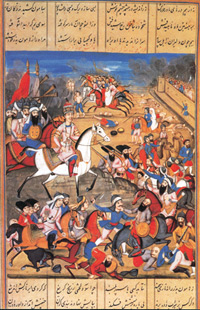 Agha Mahammed Shah’s capture and the sack of Kirman. Shahinshahama. Shaba. 1810 Opaque watercolour on paper. Copies of this manuscript were sent by Fatali Shah to English, Russian and Austrian rulers
Agha Mahammed Shah’s capture and the sack of Kirman. Shahinshahama. Shaba. 1810 Opaque watercolour on paper. Copies of this manuscript were sent by Fatali Shah to English, Russian and Austrian rulers Since Ibrahim Khalil Khan did not return to Shusha, the defenders of the fortress were without a leader and lost heart. Moreover, the feudal nobility included pro-Iranian elements. Some circumstances give grounds to think that Ibrahim Khalil Khan could not return to his fortress, as its gates had been locked by traitors. Another fact shows that Ibrahim Khalil Khan did not leave Shusha as a coward. When Aga Muhammad Shah found out about Ibrahim Khalil Khan’s retreat, he decided to catch him on the road. "Aga Muhammad Khan sent 2,000 horsemen with the best commanders in pursuit of Ibrahim Khalil Khan to catch him if possible," N. Durbinov wrote. "They managed to catch up with him when he was crossing the River Terter, but Ibrahim Khalil Khan put up fierce resistance. He routed the Persians and fled to hide in the mountains." [14, p. 209] Ibrahim Khan is highly unlikely to have been able to defeat the enemy without troops, with only his family and several noblemen.
Shusha falls to Aga Muhammad Shah
Anyway, the fortress of Shusha, which had so far managed to put up heroic resistance to the enemy, was in a difficult situation. The French historian Jean Cure puts forward an account of the capture of the fortress of Shusha by Iranian forces in 1797, which is not published in any other historical works. According to Cure, when Aga Muhammad Shah found out that Ibrahim Khalil Khan had left for Dagestan via the northern route, he sent a letter to the defenders of Shusha.z The letter said that Ibrahim Khalil Khan had run away and left the fortress to the mercy of fate: resistance was now senseless, so it would be best to surrender. At this time two groups had formed in Shusha. One of them was clearly pro-Iranian and favoured the surrender of the fortress to the enemy, calling Ibrahim Khalil Khan a coward; the other thought that the khan had gone to raise troops in Dagestan to free the fortress from the siege and proposed continuing resistance.
In his letter the shah promised that if the people of Shusha surrendered, their life, property and honour would be inviolable. "If I meet resistance," Aga Muhammad wrote, "after the fortress is captured, all the men will have their heads cut off, the women will be given to the soldiers and the city will be destroyed, as happened to Kerman and Tbilisi." [9, p. 373]
After the letter was received, a council was called with the participation of the elders, which decided the fate of the fortress. The council was at loggerheads. Commander Ismail proposed continuing resistance, as, if the enemy took the city, they would turn everyone into slaves. Ismail said, "We should not believe the promises of a crafty eunuch. Don´t we know that after resisting Aga Muhammad, Irakli fled and the people showed hardly any resistance. Nevertheless, Aga Muhammad´s soldiers killed all the men, abused the women and took many prisoners. We must not forget this and must put up resistance. If we continue to fight, Ibrahim Khan will reach us in time with reinforcements and free us from the siege." [9, p. 378] In response, the head of the clergy Mujaddid Haji Babek said that he trusted Aga Muhammad and intended to go to him and talk about surrender of the fortress. After the long debates Haji Babek climbed down a stepladder from the fortress and went to Aga Muhammad’s camp. Haji Babek told Aga Muhammad Shah that the population of Shusha remembered the tragedy of Tbilisi and would not risk opening the gates. Then Aga Muhammad Shah took the Koran, set his seal upon it and took an oath that if he met no resistance, no-one in Shusha would be harmed. At the same time he ordered the people of Shusha to pay a contribution of 500,000 ashrafi. After long persuasion Haji Babek managed to knock down the size of the contribution to 2,000 ashrafi. Haji Babek returned from the enemy’s camp and showed the Koran with Aga Muhammad Shah’s seal on it to all the elders. Money and valuables were gathered from the people to pay the contribution. Women even had their jewellery taken away.
In two days the people of Shusha had to open the gates of the fortress. The elders of the city led by Haji Babek went to meet Aga Muhammad Shah [9, p. 386], expecting to get away with just making the payment. But once Aga Muhammad Shah had taken the contribution, he ordered his soldiers to loot the city. The Iranian soldiers tortured the residents, demanding to know where the valuables were hidden. Aga Muhammad Shah, who had promised not to touch the inhabitants and sworn on the Koran, abused the civilians, accusing them of resistance and sympathy for the Russians and loyalty to Ibrahim Khalil Khan.
Ibrahim Khalil Khan returns to Shusha
Aga Muhammad Shah’s unexpected death (1797) foiled the plans of the Iranian usurper. The enemy soon withdrew. Power in Shusha passed temporarily to Ibrahim Khan’s nephew, Mammed Bey, who sent Aga Muhammad Shah’s head to his uncle as proof of the Iranians’ withdrawal and Aga Muhammad Shah’s death. Ibrahim Khalil Khan quickly returned to Shusha and rewarded the active participants in this turn-around with absolute ingratitude. Mammad Bey, suspected of disloyalty and of the murder of poet Molla Panah Vaqif, had to leave Shusha for Sheki. There he was betrayed, captured and given to his mortal enemy, Mustafa Khan of Shemakha, who soon executed him.After Aga Muhammad Shah’s death, his nephew Baba Khan came to power in Iran under the name Fatali Shah. He sent an envoy to Ibrahim Khalil Khan to demand his uncle’s corpse and his complete obedience. The Karabagh Khanate was in a difficult situation after the last two Iranian attacks and the earlier internecine war. The khanate’s economy had been shaken, most of the peasant farms had been destroyed and some of the subjects had run away. In political life the Russian orientation of the Albanian meliks of Karabagh was making itself felt more and more. At their request "it was proposed that the khan of Shusha, Ibrahim, be driven out of Karabagh and Karadagh and that an independent Albanian region be formed, which would depend on no-one other than Russia..." and that one of the more respected meliks be appointed governor. This region was to be organised in as favourable as possible a way for the population in order that other, more powerful Armenian provinces might follow the example of the Karabagh Armenians. [15, p. 100] Fearing for his authority and a fresh attack by the Iranian forces, Ibrahim Khalil Khan decided not to worsen relations with the new Iranian governor for the time being at least. He sent the body of Aga Muhammad Shah to Tehran "with great ceremony". Mirza Javanshir wrote: "Considering Ibrahim Khan’s conduct a favourable sign, Fatali Shah sent his messengers with gifts in return. He sent Ibrahim Khan a gown and sabre and put Karadagh with all its revenues under his rule and expressed his wish to become related." He said: "In the interests of peace on both sides the khan should consider his dear daughter, Aga Beyim, worthy of our harem; may she be a lady of our harem." [1, p. 86]
After taking seven months to consider the offer, Ibrahim Khalil Khan refused to give his daughter in marriage to Fatali Shah. The furious shah prepared a 12,000-strong detachment to send to Karabagh to punish Ibrahim Khalil Khan. When he found out about this, the khan sent a letter to the commander-in-chief of the Russian forces in the Caucasus, Kovalevskiy, assuring him "of his loyalty to Russia" and asked how he should behave towards Fatali Khan who had already made claims on his khanate." [14, p. 292] Kovalevskiy did not answer the letter. Faced with the prospect of destruction of the Karabagh Khanate yet again by Iran, Ibrahim Khalil Khan was eventually forced to give a positive response to Fatali Shah. This should be viewed as marriage diplomacy. Ibrahim Khalil Khan’s daughter Aga Beyim, was sent to Fatali Khan’s harem in Iran and his son Abulfat Aga as a hostage. Making him military emir, Fatali Khan persuaded him to support friendship with Ibrahim Khalil Khan and wean him off orientation towards Russia. After marrying Ibrahim Khalil Khan’s daughter, the shah sent the khan every year "different presents, gowns, sabres, horses with golden saddles and harnesses, etc." [1, p. 88]. This continued roughly until Eastern Georgia fell under Russian patronage in 1801.
F. Aliyev (1929-1996), doctor of historical sciences, professor, was the chief of the Khanlig Period department of the Institute of History of the National Academy of Sciences of Azerbaijan.
Literature
1. Mirza Djamal Djavanshir, Istoriya Karabakha, Baku, 1959
2. Mirza Adigozel Bey, Karabaghname, Baku, 1950
3. P.T. Artunyan, Osvoboditelnoye dvizheniye armyanskogo naroda v pervoy chetverti XVIII veke, Moscow, 1960
4. Akhmed bek Djavanshir, Istoriya Karabakhskogo Khanstva, Baku, 1961
5. Abdul Qasan ibn Mukhammad Amin Gulustane, Modjamul tavarikh Shiraz, 1190 (hijri), (in Persian)
6. M.M. Musatafayev, Ekonomika Karabakhskogo Khanstva, Berlin, 1949
7. V.N. Leviatov, Ocherki iz istorii Azerbaydzhana v XVIII veke, Baku, 1949
8. O.P. Markova, Rossiya, Zakavkazye i mezhdunarodniye otnosheniya v XVIII veke, Moscow, 1966
9. Jean Cure, Ventsenosniy skonets, Tehran, 1361 (1982), part 1, (translation from French)
10. TsGVIA, f.VUA, d.18474
11. P.Q. Butkov, Materiali dlya novoy istorii Kavkaza... SPb, 1869, part II.
12. AVPR, f.SRP, op.77/I, d. 158 (1796)
13. Istoriya Azerbayzhana, Baku, 1958, part I
14. N. Dubrovin, Istoriya voyni i vladichestva russkikh na Kavkaze, SPb, part II, 1886
15. G.A. Ezov, Snoshcheniya Petra Velikogo s armyanskim narodom, SPb, 1998
16. Faruk Syumer, Rol anatoliyskikh tyurok v obrazovanii i razvitii Sefevidskogo gosudarstva, Ankara, 1967 (in Turkish).
